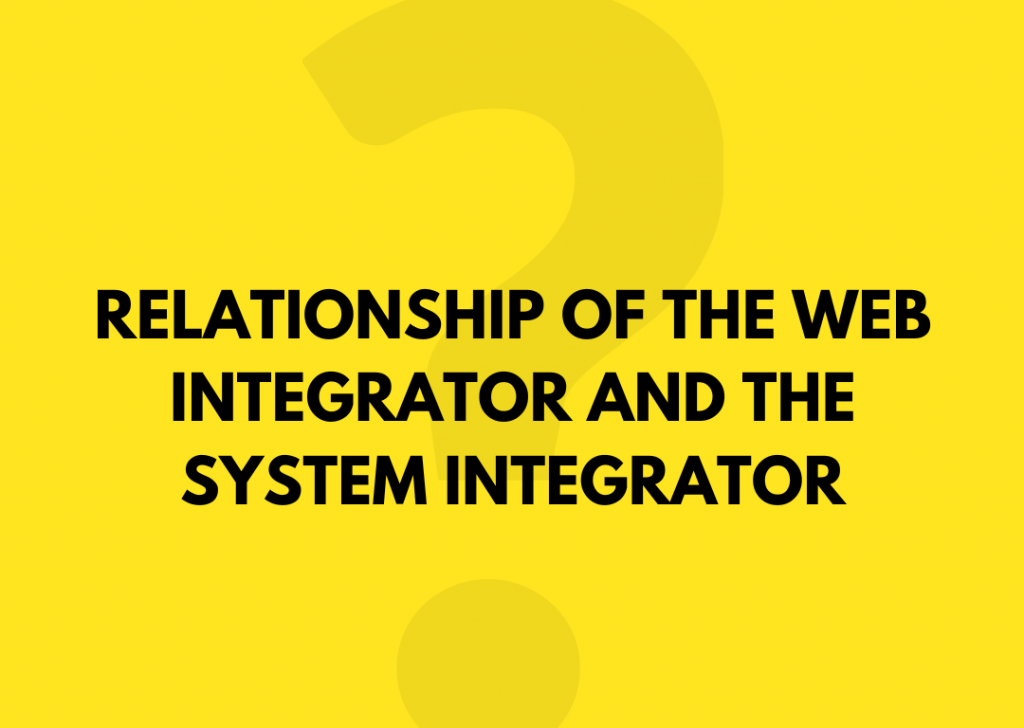
Relationship of the Web Integrator and the System Integrator
Brief contemplation on the methods of how a Web Integrator may cooperate with a System Integrator within a web-integrating project.
Also, you should not miss the previous part of the article series about web integration – How to apply the principles of three-tier architecture in a web integration project. It is a must-read!
Who is the System Integrator? I like the definition on Wikipedia – “A systems integrator is a person or company that specializes in bringing together component subsystems into a whole and ensuring that those subsystems function together…”. Typically, it is a company that consults and brings together solutions from the existing or newly developed sections. In practice, often comprehensively for a specific client.
As stated in the definition of a Web Integrator, definition of Web Integrator’s activities as compared with the System Integrator are as follows:
“Unlike the System Integrator, the Web Integrator includes in his services also the area of marketing and communication and new Internet disciplines, but not areas related to internal systems, such as data warehouse problems, DMS, ERP, etc. Both, the Web Integrator and the System Integrator cooperate most frequently in defining interfaces to internal client’s systems which are to be used for implementation of a web solution and in proposed optimisation of the processes involved.”
But how can such cooperation look like in a specific project?
System Integrator as a General Contractor. Web Integrator as a subcontractor.
From my point of view, it is a typical scenario when the System Integrator delivers a complex change (or implementation) of several systems that also very often deal with an on-line frontend. The frontend must however be understood in the context of a three-layer architecture as a presentation section, thus including systems necessary for administration, operation and integration.
However to secure the frontend as well as other specific parts of the supply, the System Integrator needs a subcontractor-specialist. In my opinion, the System Integrator alone has often not enough powers, in particular in the area of UX, multi-channel communication, and on-line marketing. Conversely, they overlap in the area of the development and operation.
The System Integrator is responsible for the design of complex system architecture, delivery within the quality and terms agreed on, and often also subsequent service and development. The Web Integrator is responsible for the delivery of his part, including coordination of his eventual subcontractors. Indeed, he is also a partner of other subcontractors, in particular within the integrating interface necessary for interconnection of the presentation layer and the business logic layer.
Web Integrator and System Integrator as partners
In certain cases, the client organizes alterations of internal and frontend systems independently, and often also in different times. The client possibly does not require General Contractor’s services.
In such cases, the Web Integrator and the System Integrator are partners who must deal with mutual coexistence of supplied systems and their integration. Both parties must cooperate in both, the delivery and subsequent service within the powers agreed on.
The defined interface between the presentation layer (frontend) and the business logic layer is a suitable and demonstrable boundary of powers. So it is possible to minimize risks resulting from unclear division of powers.
The analogy of this cooperation model is a variant when internal systems are not provided by single System Integrator, but by several independent contractors. In this case, the competence matrix is of course more complicated. And its complicacy correlates with the number of integrating links to various systems (and the number of contractors). This variant however does not fall within this contribution, since no System Integrator is involved in it.
Web Integrator as a primary contractor
Theoretically, a variant opposite to the first option comes into consideration. Thus a situation when the Web Integrator is a primary contractor and provides also services falling within the System Integrator.
I must say that I have not encounter this variant in practice yet, and it does not make much sense to me. Powers necessary for correct management of system integration on the level of internal systems reach far behind the framework of Web Integrator’s powers as we understand them within the web integration. Thus from my point of view, it would be some necessary business compromise, but without material grounds.
And what does emerge from this?
In my opinion, the cooperation of the Web Integrator and the System Integrator is a key issue (if applicable) for perfect management of the on-line frontend of the supplied solution. Eventual failure to manage this cooperation will be experienced by end users. With respect to the frontend nature, these end users are customers; it will thus have an immediate negative impact on the business. Conversely, good cooperation might improve essentially business results of the whole solution supplied. And as we know, money is always in the first place.
You can now follow to the next part – article called: Relationship between Web Integrator and Digital Agency.
Was this article helpful?
Support us to keep up the good work and to provide you even better content. Your donations will be used to help students get access to quality content for free and pay our contributors’ salaries, who work hard to create this website content! Thank you for all your support!
Reaction to comment: Cancel reply